Glossary
Just some of the words you might like to know
Anvil
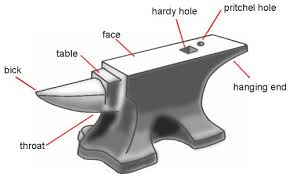
Multi-purpose tool, used to shape hot metal. Comes in numerous styles and sizes, according to the smith’s requirements and preferences. The tapering Horn or Bik (beak) is used for rounded work but the flat top is most widely used. Different tempers in the top make it used for different purposes. Most include a square socket to make ancillary tools.
ARC welding
Cheapest and easiest of the various welding methods, using inexpensive equipment and plug-in box. Suitable for most ironmongery jobs but will not weld cast iron and leaves a highly distinctive join
Architrave
Moulding to accentuate doors and windows, covering join between plaster and door/window lining. Comes in various patterns and sizes
Arris
An architectural term… commonly used to describe the horizontal triangular rail used to strengthen a fence midway up, where the diagonal edges prevent water from collecting and rotting the timber, while also making it harder to climb
Arrowhead
Commonly used as decoration at the end of garnet hinge, especially in later imitations, in cast-iron or blacksmith work
Artex
Flexible acrilic paint, bulked up to provide a textured surface to walls and celings, whilst covering plaster cracks. Easy to apply but currently out-dated. Early formulas sometimes included asbestos, making removal hazardous
Ashlar
Dressed stone work, using large rectangular blocks with square edges and even faces, generally 13 to 15 inches in height. When smaller than 11 inches, they are usually called “small ashlar”. Once widely used as an alternative to brick. Generally the external face is smooth or polished, occasionally decorated by small grooves achieved by the application of a metal comb, known as mason’s drag.
Back set
Measurement on a latch or lock, between the centre of the handle and the edge of the door. Most modern locks and latches use a shorter mechanism, which is easier to install but leaves little room between the handle and the door lining, making conventional knobs unsuitable and levers the only option
Bailey
Tool maker, esp. planes
Band
Length of iron used to strengthen a door or wrapped around at the end to form a sleeve fitting onto pintle as hinge. Often the smith used a worn out cartwheel, hence the heavy square, inset nail holes.
Band Saw
Machine-driven saw, using a long continuous blade for planking a tree trunk. It leaves straight, parallel cut marks. The blade can be thinner than a circular saw, making a more economical cut.
Barrell bolt
Sliding bolt, with round slide… difficult to make by hand until steel mills could produce standard, round-section bar Incorporates a ‘tower’ (small knob, shaped like a fairy-tale castle turret) on the slider, which can turn to engage the tower in a slot on the casing to keep it in place, open or closed. Modern versions have a slotted plate instead, which goes over an beyed staple, to take a padlock.
Bead and butt
Tongue and groove boarding adds strength and helps prevent warping by interlocking adjoining boards. Floorboards are traditionally T’n’G. butt joined but wall boarding commonly comes with both sides slightly bevelled to leave a V groove. Bead and butt instead incorporates a half-round bead on one edge, for decoration. Often difficult to find, especially in wider and thicker dimensions.
Beading
General term for decorative strip of wood, usually used to cover joints between adjoining timbers. Usually comes in 2-metre lengths, in various cross-sections.
Bean
Bean-shaped fixing pad for thumb-latch. Probably an American design now copied in Britain but rare in original material. The same pattern can be used as decoration on ‘T’ hinges.
Bees Wax
Gives a distinctive and lasting finish if used by blacksmiths to cool or temper red-hot metalwork Traditionally used by cabinet makers to fill small holes, such as knots or splits. Softened to a paste with white spirit it is used as furniture polish. Also used by smiths to quench hot metal, leaving a pleasant distinctive sepia finish but paint-like, obscuring the surface of the metal beneath.
Bik
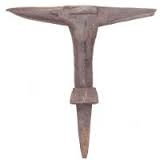
aka beak, pointed end of the anvil, or alternative term for stake.
Blind Tenon
Tenon for mortise which does not extend right through the wood. More difficult to make, especially to wedge, but protects end grain from weathering and also leaves a smooth edge for door or window casement.
Blockboard
Type of plywood much favoured in mid/late 20th century. Two or three layers of thin veneer, often birch, sandwich long strips of softwood one inch square or similar.
Board
Plain wood, usually of small dimension, up to 1″ thick. The younger trees used today mean that wider boards are difficult to find and liable to warp. The width of floorboards is a usual indicator of the age of a property. Not to be confused with paneling.
Boat nails
Widely used as substitutes for hand-made roseheads because the head is raised, roughly pyramidal and ‘looks the part’. The shank is cut and waisted, so it works as well.
Bolster
Wide chisel, used for brick or stone.
Bottom rail
Term used to describe the bottom timber in a door or window casement. Increasingly narrow, as machine-made joints and modern glue allow joiners to economise on timber and maximise glass area.
Box lock
Old version of rim lock, with lock mechanism is built inside a block of wood, screwed to the door or held with metal straps. Later versions use a standard mortise lock encased in a block of wood.
Brace
Hand tool with cranked centre section to enable hand boring of large (10mm plus) holes in timber/ Also refers to diagonal timber used tp strengthen boarded door
Brad
Small nail. Can be used for short wire nails, or ‘flooring brads’ which are cut nails.
Brass
Rarely used for ironmongery until late 19th century, except for some moving parts in locks and occasional embellishment, eg knobs on latches or bolts.
Brazing
Expensive but neat way to join many metals, using a silver/copper/zinc alloy. Metal must be carefully prepared but resulting join is extremely strong and particularly stress and vibration resistant
Brickie
Site slang for bricklayer.
Bullnose
Cheap, universal moulding widely used in modern building for skirting boards and arcitrave. One edge is simply rounded off.
Butt Hinge
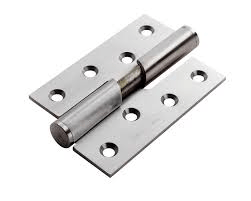
Conventional rectangular, symetrical hinge. In various sizes and materials, usually with countersunk fixing holes. Pre-20th century versions were often in cast iron. Lies flat and is normally rebated into adjoining timber so it does not ‘show’ on completion.
Butterfly
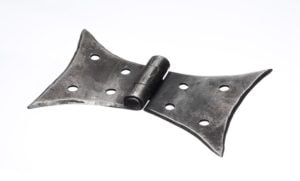
Type of hinge used for cabinet work, and especially for cupboards built-in to chimney breasts, So called from its shape.
Cabinet maker
Furniture maker
Carpenter
Construction timber worker, working on-site (chippie)
Case-harden
Process to harden the surface of a cutting edge or similar, usually by dipping the red-hot metal into a bath of a carbon-rich powder. Traditionally a smith might use horse-hoof shavings. A similar process is widely used today to harden saw teeth so the resultant blade has the flexibility and resilience un-suitable for a cutting edge.
Casement
The opening part of a window. Usually timber but also sometimes metal (iron for old lattice windows, aluminium for modern double-glazed ‘units’) or plastic. Before cheap glass it was frequently a simple shutter, often sliding sideways.
Chipboard
Manufactured timber, using wood chips and a plastic resin. Once highly susceptible to wet but now mostly water-resistant. Unsightly, textured finish, heavy, hard to cut and not very strong. Mainly used for cheap flooring, although sheet size makes access to under-floor services difficult.
Chippy
Site slang for carpenter.
Chisel

Long-handled tool with cutting edge, used mainly for wood. Many particular patterns designed for particular jobs.
Cill
Bottom component of door or window frame. Frequently in hardwood, moulded to shed rain, with anti-drip groove on the outer, underside. Inner face may be grooved to take window board.
Circular Saw
Once used for planking tree trunks, but now largely replaced by bandsaws, because of high wastage. Leaves distinctive arcs of saw marks. Now smaller versions widely used on site.
Clamp
Temporary tool for holding pieces before fixing.
Clasp nail
No longer widely used… A cut nail with the head ‘spread’ by machine to an oval shape, slightly raised.
Cleft
Split. When saws were expensive, inefficient and wasteful, much timber was split along the grain, using a froe, to produce building timber or panelling.
Clench
Bending a nail to lie flat on a board from which it has emerged, for extra strength. Difficult and possibly unnecessary with a cut nail.
Coach Bolt
Round head bolt, with smaller square head beneath, tightened only by square. Usually with hexagonal nut.
Coach Screw
Heavy-duty tapered wood screw, with a square or hexagonal head to take a spanner.
Coping saw
Small hand saw with thin disposable blade for cutting curves.
Corporation Hinge
Strap hinge, with dog-leg offset to allow door to fit inside frame, un-hindered by pintel.
Counter bore
Drilled hole to enable head of screw or other fixing to sit below surface.
Counter-boarding
Boards set across the grain of adjacent boards, for instance on the inside of a door, providing extra strength and resistance to warping and making a door inpenetrable to an intruder’s axe.
Countersink
To widen a screw hole and enable suitable screw to sit flush or below surface.
Coxcombe

Decorative hinge, to spread fixing holes across greater area of timber. Pattern resembles silhouette of cockerell’s head. Especially used on Jacobean oak furniture
Cross-head
Late 20th century screws with inset cross on the head to take specially designed screwdriver, eg Phillips screws.
Cut nail
One cut, that is stamped, from mild steel sheet. Cheap and having remarkable grip. Widely used for construction work, especially nailing down floor boards.
Dado
Decorative moulding, horizontally on wall about waist height. Sometimes used to finish boarding or panelling below.
Deadening
Technique to improve grip of a nail, using a ‘Dolly’ such as a heavy hammer head to prevent an oversize nail emerging on the back side and forcing it to crimp inside the wood when hammered home.
Deal
Whitewood. Earlier term for ‘pine’. Red Deal was mainly from Scots Pine, White Deal, Norway Spruce.
Door Frame
Substantial rectangle around doorway, with heavy load-bearing timber verticals and load-bearing lintel, now widely replaced with door lining fixed to masonry or load bearing timber studwork.
Door Lining
Timber board, fixed in doorway to cover plaster, masonry or structural timber and to take hinges.
Drummond
Small lathe maker.
Espangolette
System of bars and levers for door catch and/or lock, with waist-height handle and locking pieces at top and bottom of door or window. Can be concealed or surface mounted.
Eye
Hole. Often used to describe mounting hole in strap-and-pintle hinge.
Feather-edge Board
Weatherboard with V cross section to allow simple overlap, with nails through top (thick edge) and lower (thin edge) board.
Fire weld
Process to weld iron using forge, difficult to apply to modern mild-steel but widely used with soft iron.
First-fix
Elements of a building which have to be completed before plastering, including plumbing and electrical layout, and interior structural timberwork.
Fish tail
Semi-decorative finish for bolts, handles or window furniture, where metal is splayed out and curled back to make a small handle or grip.
French Polish
Varnish of shellac and methylated spirit, applied to cabinetwork to provide a high-gloss stain or finish. Now superceded by poly-urethane or water-based varnish but still used under paint to stop knots from bleeding resin.
Froe
L shaped axe with long narrow blade for accurate splitting timber instead of sawing. Used with a maul rather than by swinging. Used to make panelling, roofing shingles or construction timber
Galvanise
Process to rust-proof steel items by dipping in molten zinc to form a thin, grey surface which can be painted and will not corrode. A cheap, durable and efficient method of weather-proofing mild steel.
Garnet
More commonly referred to as ‘T’ Hinge. Comes in many patterns, with various designs for the knuckle and ornamentation. Commonest is a disc, (the ha’penny end), but other versions include ‘bean’, an American design where the end is kidney shaped., the Welsh, where the end is a semi circle (widely used on chest hinges) and the Arrowhead, a version much favoured in the 19th century and by firms producing cast copies of wrought-iron work
Gas welding
Welding using hi-carbon gas, such as acetylene or more recently propane or butane to melt and merge adjacent steel surfaces. Requires some skill, expensive equipment and dangerously flammable/explosive gas cylinders.
Green
Un-seasoned, especially of oak. Such timber is easier to work but more liable to splits and bending. Water content and tannic acid makes it highly corrosive for ferrous fittings and liable to metal staining.
Gripfill
Descriptive trade name for modern, gap-filling adhesive, said to be remarkably strong, in situations where conventional contact glues would be little use.
H Hinge
Similar to Butt Hinge, but with arms that extend above and below the knuckle.
Holy Lord
Holy Lord – H L – with extending arm to go on door, so they come in pairs, top and bottom. Occasionally cut down. Widely used on pannelled doors, where the L part strengthens the corner joints.
Hook
Specifically, of hinges, the mounting piece set on door frame incorporation a vertical post on which the door component will sit. Sometimes called Pintle.
Horse
Small narrow table, used on site as work bench or stand, sometimes with fitting to allow workpiece to be gripped. As ‘Saw Horse’.
Iron
Low-carbon content ferrous metal, craft-made and now hard to find. Produced now as ‘living history’ at Ironbridge Gorge. Easy to work and rust-resistant but soft and not so strong as mild steel.
Joiner
Work-shop based timber worker. One who makes doors, windows etc.
Joist
Horizontal floor-bearing timber between larger steel or timber beams or between walls.
Joist Hanger
Pre-fabricated metal sling to take joist, eliminating the need for cutting mortise hole in masonry or joint with other timber, nailed in place or slotted into mortar crack in brickwork
Keeper
Metal fitting to secured catch or bolt, for example the hook-like piece on a door frame or lining which engages with a Suffolk latch.
Knot
Feature of timber resulting from an off-shoot branch in the original tree which results in a change in colour and grain direction, often bleeding resin after seasoning and harder than surrounding timber.
Laminate
Factory-made wood, composed of smaller or thinner wafers of timber glued together, as plywood or glulam beans. Also in ‘Engineered’ plywood flooring, or ‘laminate’ flooring which is usually a synthetic decorative surface on MDF or Chipboard.
Ledge
Specifically, horizontal boards on back face of boarded door, to hold the face boards together. Better quality boarded doors also incorporate diagonal Braces to prevent any sag.
Library Strip
Thin slotted strip on either side of bookcase to take pegs supporting adjustable shelving, of brass or similar. Surface or flush mounting.
Lifter
Latch bar, which pivots up and down on to engage keeper on door frame or lining, usually by thumb lever through the door. Earlier timber versions were lifted by a pull string or through a thumb-hole in the door.
Linen-fold
Traditional carving pattern, widely used on cleft pannelling, to resemble folds of cloth.
Lintel
Load-bearing timber, or occasionally stone or now concrete or steel, over door or window.
London
Victorian pattern of T hinge, where the knuckle/pin extends the length of the shoulder.
Malleable
Softer, lo-carbon steel, used for casting small fittings, so they are less brittle than ordinary cast iron. Widely used for re-production ironmongery.
Marks
Series of small cuts or grooves, like Roman numerals, to mark timber joints for re-construction at a later date, for instance on site after building timbers were cut and pre-assembled elsewhere.
Marples
Tool maker, esp chisels.
MDF
Medium Density Fibre. Similar to Chipboard but stronger, with a finer surface. Introduced first as 8 x 4 foot boards, more recently for architrave, skirting board, window board. More workable than chipboard.
Melamine
Plastic surface applied to chipboard or MDF, mostly for use in kitchens and flat-pack furniture.
Mild steel
Modern stock for most general purposes. Higher carbon content but cheap to produce. Comes by the metre from the rolling mill in a variety of cross-sections. Rusts more easily than wrought iron and is more difficult to work, especially fire-welding.
Monkey Tail
Semi-decorative finish to for bolts, handles or window furniture, where metal is curled into a spiral and curled back to make a small handle or grip.
Mortise
Rectangular hole in timber to take tenon.
Mortise lock
Lock or lock/latch hidden within the thickness of the door, in a mortise. More difficult to install but neater (can affect the strength of the door).
Moulding
Length of decorative timber, such as architrave. Once made with fluted moulding plane, now with electric router (on site) or spindle moulder (in joinery shop).
Mullion
Vertical post between window frames, frequently load-bearing to support lintel. Can be brick or timber, or stone, often a single, dressed stone.
Muntin
Horizontal timber component of door, around waist height, to provide lateral strength and suitable mounting for latch or lock.
Myford
Small lathe maker.
Nail punch
Punch used to ‘bury’ nail heads below the wood surface. Used with hammer. Contact area normally slightly concave to engage better with the nail head.
Needles
Short sturdy temporary timbers inserted through wall and supported at either end to take weight while an opening is made below until a permanent lintle can be built in.
Norfolk Latch

Later version of Suffolk latch, incorporating back plate.
Ogee
Moulding profile widely available for skirtings, architrave or window casements. Today, frequently combined with a Torus moulding enabling carpenter to choose preference
Oval nail
Oval in cross section, straight, with smaller head, mainly used for ‘second fix’ carpentry, eg fixing door linings and stops
Panel
Thin, wide board on door, walls or furniture, where strength is provided by surrounding framework.
Panel pins
Small thin nails, for delicate work.
Parkinson
Vise maker.
Parliament hinge
Hinge allowing offset, so that, for instance, a door can open back on itself to lie flush against adjoining wall. Takes more stress than conventional Butt or Garnet hinge and needs to be stronger.
Pear Drop
Semi-decorative finish to for bolts, handles or window furniture, where metal is formed into tear-drop and possibly curled back to make a small handle or grip.
Piano hinge
Compact, light-weight hinge, sold in 2 metre lengths or similar, for eg piano lids.
Pintle
Originally Pin Tail. Hook, mounted in pairs, on which to hang Band or Starp of a hinge, before introduction of conventional hinge with captive pin.
Pit saw
Two-man rip saw, for cutting planks from log, leaving distinctive, straight but not parallel saw marks. So called because the log was held horizontally, with one sawyer above, and one below, working in a deep pit.
Plumb
Vertical… as gauged by Plumb Bob, a smaller weight, originally lead, on a long cord (plaited, not twisted).
Plywood
Laminate made from thin wafers glued together in various thicknesses and qualities, usually in sheet form. Modern glues are more damp-resistant than formerly and less attractive to woodworm.
Powder-coating
Electrostatic process applied to mainly small metal items, giving a thick, usually black, corrosion resistant finish.
PSE
Planed Square Edge, referring to planed boards without moulded edge or tongues, grooves etc.
Pull-string
Early device to lift door catch (usually wooden) with a string or thong from the other side of the door.
Purlin
Horizontal timber or steel supporting rafters.
Rafter
Sloping roof timbers.
Rebate
Right-angled groove cut in the edge of a timber, usually to accommodate glass or panels.
Record
Tool maker with extensive range of joinery and cabinet tools.
Red lead
Traditional paint incorporating lead oxide, turpentine and linseed oil, used as primer, now mostly on metal.
Return
Describing wall or pther structure at right-angles to another.
Rim lock
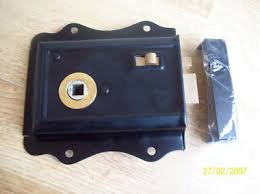
Lock and/or latch, fixed to the door. Components are mounted on a metal backplate, the whole covered by a metal case.
Rising butt
Variation on conventional butt hinge, so the door lifts as it is opened, to clear carpets, uneven flooring and so the weight of the door pulls it shut. Not widely stocked.
Riven
Split. When saws were expensive, inefficient and wasteful, much timber was split along the grain, using a froe, to produce building timber or panelling. Also frequently used of stone.
Rose-head
Old-fashioned nail, hand-made in a small jig, with a large, raised pyramidal head. Made of soft iron, with a poor grip which made clenching or deadening almost essential.
Router
Formerly elaborate plane, now used of an electric hand or table tool, cutting grooves or channels horizontally. Interchangeable cutters enable a wide rane of profiles. Can be used freehand or with jig or fence.
RSJ
Rolled Steel Joist, widely used for major structural support.
Sash
Window casement opened by sliding up or down, on spring or counter-balance weights, Formerly sliding side-ways.
Second-fix
Post-plastering tasks, such as connection electrical and plumbing fittings and timberwork such as skirtings, architraves.
Secret nailing
Technique widely used for T&G (tongue and groove) boarding.
Shake
Split in timber, usually occurring through bad seasoning.
Shiplap
Type of weatherboard, designed to shed rain and minimise possibility of rotting, whilst economising on fixing (two boards being nail together at the overlap).
Shoulder
Hinge component fixed to the door frame. Also joiner’s device to strengthen mortise and tenon joint.
Side-axe
Short-handled axe sharpened on one side only for trimming large timbers to square.
Sill
See ‘Cill’.
Silver solder
Alloy of silver, copper and zinc (cadmium content is now being phased out) for joining red hot, close-contact joints in most ferrous alloys. Expensive but extremely strong and vibration resistant. A flux of borax is used.
Skirting board
Moulding to cover gap at the base of a plastered wall to cover gap between floor and plaster (the gap is to prevent any movement in the floor from cracking plasterwork).
Solder
Lo-melting alloy of tin and lead, used to join close-contact surfaces in copper, tin-plate or brass and especially in copper pipe-work by plumbers. The lead content is now often replaced with an alternative metal. Use of of a patent flux or ‘killed spirits (Zinc Chloride).
Sparks
Site slang for electrician.
Spread
Site slang for plasterer.
Stake
Small anvil, long and narrow with tapered square base designed to fit into standard square slot on conventional anvil and widely used by sheet metal workers.
Stanley
Tool maker, esp. planes.
Strap
Long arm of T or garnet hinge or restraining band to hold timber in place.
Stud
Constructional timberwork, comprised of vertical posts with horizontal spacers or diagonal bracing. Now widely used with plasterboard for internal walls. Formerly used with brick, flint or mud infill or with wattle and daub covering.
Suffolk Latch
Traditional thumb latch, with thumb operated lever through the door raising a lifter to disengage from a keeper on the doorframe. Different designs of the fixing pads and of the lifter seem to have a regional significance.
Swage
Tool held with tongs and hammered to cut or shape hot metal, or shape formed in tool into which hot metal is hammered.
Traditional thumb latch, with thumb operated lever through the door raising a lifter to disengage from a keeper on the doorframe. Different designs of the fixing pads and of the lifter seem to have a regional significance
Swan-neck
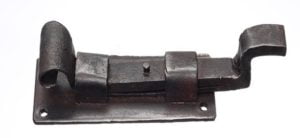
Offset in a bolt or pipe to accommodate otherwise unsuitable layout.
Tenon
Rectangular ‘finger’ formed at the end of a timber piece to engage in like shaped slot (mortise) in another timber.
Threshold
Heavy timber beneath door. Thought to originate from practice of threshing grain on a wooden threshing floor.
Thumb hole
Hole in door to access catch on the inside with thumb or finger.
Tongue and groove
Device to interlock boarding, for strength, resistance to warping and to prevent draft and appearance of cracks between boards. Makes ‘secret’ nailing possible. Occasionally floor boards were ‘joined’ with a thin metal strip sunk into matching boards on either side.
Torus
Moulding profile widely available for skirtings, architrave or window casements. Today, frequently combined with an Ogee moulding on the other side of the board, so the carpenter could use either.
Tower bolt
Sliding bolt, with round slide… difficult to make by hand until steel mills could produce standard, round-section bar. That enabled it to rotate, with a protruding knob, the ‘tower’, slotting into purpose made holes in the casing to hold it in place, replacing the ingenious but difficult-to-make ‘fishtail’ bolt.
Universal Beam
Similar to RSJ but with a slightly different cross-section and with different characteristics.
Wainscot
Vertical boarding on the lower part of an inside wall, to hide rising damp. Occasionally panelled.
Waisting
A nail is ‘waisted’ if it is thicker part way down its length than it is under the head, giving it extra grip.
Wattle
Hazel or willow wands, woven around similar vertical uprights to fill between studding and covered with ‘daub’ (cow dung and mud) for cheap wall.
Weatherboard
Boarding such as feather-edge or shiplap, to clad building exterior.
Wedge
V-shaped piece of wood hammered into the end grain of a tenon for extra strength, or to secure the head of a tool, such as axe or hammer, onto the shaft. For tools a smaller steel wedge may also be used.
Welsh hinge
Garnet pattern ‘T’ hinge, with a semi-circle at the end. Origins unknown.
Welsh latch
Similar to basic Suffolk latch, but the lifting bar incorporates a lip with which to pen the door, so the thumb-piece lever is not extended to make a grip for disengaging the latch and opening the door.
Wire nail
The common nail today… circular cross section, straight with sharpened point and round, flat head, usually with annular grooves and ridges for added grip just below the head.
Woden
Vise maker
Woden
Literally, worked, often used for ornamental twisted or bent metalwork, even cold-worked. ‘Real’ wrought iron is soft and essentially hand-made. It is rust-resistant, easily worked and difficult to obtain.